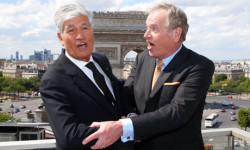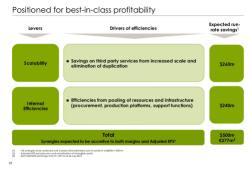The Publicis Omnicom Groupe merger is over. Nearly a year after the original announcement on 27th July 2013, Tom Denford looks at the impact of the #POGFAIL on advertisers, media billings and other important stakeholders.
“It is with hearts full of sadness that we have decided to separate. We have been working hard for well over a year, some of it together, some of it separated, to see what might have been possible between us, and we have come to the conclusion that while we love each other very much we will remain separate.”
When the news of the failed Publicis Omnicom Groupe (POG) mergertrickled through on Thursday night, I was immediately shocked but not hugely surprised. A deal which appeared from the outset to be flawed in strategy and rationale found it impossible to complete, despite momentum and appetite on both sides, at board level at least. But the shock and surprise this week at the deal’s failure was nothing compared to the shock and surprise we all experienced in July 2013 when the merger was first announced.
In July, swiftly after the announcement, I gave an ID Comms’ media perspective on the implications of a Publicis and Omnicom merger for advertisers, with particular focus on the impact of the groups merging their considerable media billings. Reading it back now I think the skepticism was accurate and the areas of concern (the purpose, rationale and motivation of the deal and its benefits to advertisers) were correct. However, I never considered for a minute that the merger could not happen or would not be able to complete.
At the time of the announcement in July 2013, you may have been hard pushed to find two less suited advertising companies for a merger (of the 6 "big ones”) in terms of culture, strategy, structure and (conflicting) client roster. Hence the reaction from the industry was one of incredulity as much as wonder: How did this happen? How did Maurice and John, these once steel-eyed corporate enemies, become these jovial, gurning, charming chums on the roof gardens of 133 Avenue des Champs-Elysees?
In hindsight we can see that it was probably handled pretty badly and that an “awkward” merger of equals such as this relies on meticulous communication management, luck and a fair wind as much as any technical M&A expertise to see completion. The communications part of the merger preparations was particularly poor and probably contributed largely to the internal resistance / apathy (delete as appropriate) that the two companies found amongst their considerable 130,000 strong workforce.
Clients were quick to rightly ask the question “So, whats in it for us?” to which no satisfactory answer was ever really supplied. Internal communication within the groups was kept to a minimum and senior agency stakeholders quickly became tired of being asked by clients (and consultants, and journalists and everyone) for an update on the merger, its timeline and its benefits. There were no updates to share. Even when it came, the news of the collapse upset some Omnicom clients who felt they were slow to be told (again).
“If I had to summarize in a tweet it would be, corporate culture, complexity and time. And I would still have 100 characters left.”
John Wren on why it failed
A conscious uncoupling
There is no real value in picking over the bones of the failed deal, lots of stories will inevitably flow from Publicis and Omnicom themselves over the coming weeks. This will highlight one of the biggest threats to both groups in the months ahead; there is already sniping happening, see these press briefing from top to top and it won’t take long before what they have learned about each other in the last 10 month's disclosure and the insights gained into each other’s companies will become the fuel for a public war of words under the guise of damage limitation and reputation building.
The danger is that they both suffer significant collateral damage post-merger as they brief against each other in the press and to staff. There will be a lot of material to draw upon, the two companies have spent the last 10 months sharing information, numbers and strategies with a view to coupling. In October, the 100 top execs from both sides met in a “secret” Miami conference where the whole cake was examined and provisional cake cutting strategies were determined. So the uncoupling of the two sides from merger talk will leave them both a little exposed and raw, their normally sharp competitive advantages may be somewhat blunted as they slowly rebuild their walls of confidentiality and reengage each other in old-style pitch combat.
The impact, from a media perspective
Media was the biggest area of the groups where collaboration presented advantages for both the group (status in Silicon Valley) and clients (some additional small leverage on price and access was potentially there) and so this will be an area where agencies from both groups will be keen to get off to a good start to prove their individual prowess and re-inflate the agency pride which had been softened by 10 months of internal politicking, preparing for collaboration. Everyone knows, media pitches can be hard fought, bare knuckle death matches when agencies are at their most hungry to win. OMD and Starcom are now fierce global competitors again.
In our original commentary on the deal announcement in July 2013, we considered the impact of the merger on a selection of important media stakeholder groups, namely Clients, Vendors, Employees, Other marketing service groups (especially market leaders WPP), Shareholders and Investors. In this follow up we will take a look at each in turn again, this time considering the impact that a very conspicuous "conscious uncoupling” will have on these stakeholders this time around. The collapse of the merger is uncomfortable for a few people in the short term but probably good news for all concerned in the long run. Let's consider some of the impact of Thursdays news, again through the lens of media billings especially...
Brands / Clients:
"The Top 20% of agency clients"
As we stated in our post last year, the top 20% of the agency group's clients were the ones most likely to gain some of the value from the merger. Now that the two groups have retreated to be stand alone giants, both will be wanting to sure up their client rosters and the immediate priority will be to their top 20% of clients. If you are a top 20% client of Publicis Group of Omnicom Group the ball is in your court. While the merger wounds (or are they carpet burns?) remain sore, this could be a perfect time to open a conversation with the leaders of your agency and investigate how important you are to them now and for the future. For confidential advice click this magic button.
Media Pricing
In a dream scenario the merger of Publicis and Omnicom group media billings provided the combined group with huge additional leverage against media vendors' pricing and the result would be value delivery for media clients. We were all rightly skeptical that this could be achieved in any reasonable time frame, it took WPP more than 3 years to get GroupM, its group media trading unit, to a state of functioning value creation. Even in a best case it would have taken the merged POG at least two years, probably more, to sufficiently integrate their buying resources to make that an effective negotiation leverage and reduce media pricing. We had heard examples from some smaller European markets that Publicis and Omnicom group media agencies were prematurely approaching (or threatening?) media vendors as a collaborating unit to test the benefits of scale leverage and see if prices could be nudged down. Now that the merger is off, this is all academic. What looked good in theory will never come into practice. Move on.
Client Conflict
Client conflict was a well documented concern of the merger, pitting iconic brands (Coke and Pepsi amongst many others) against each other in the same group. Conflict like this is never going to really be a problem, big agencies are adept at managing conflict. A big question was whether this would trigger a swathe of pitches by disgruntled clients; none materialised and I know of no advertiser who conducted a pitch in the last year because they didn't agree with the merger. Certainly in media circles Publicis and Omnicom media agencies have been defending business in the last year, a lot of it ending up at WPP media agencies recently, but what can we read into that? As I understand from insiders, WPP's recent successes have more to do with WPP aggressively chasing business wins (for example making big commercial commitments in media pitches) rather than any particular client distaste with POG.
A change of strategy made POG less relevant
Two years ago, while most countries were technically out of recession, corporate strategies remained stoically obsessed with protecting the bottom line. Agencies were becoming fatigued by "efficiency driver" strategies in marketing (and procurement) that were thin-slicing agency resources and damaging margins (and morale). With economic conditions generally improving, most marketers are now focused on top-line growth strategies for their businesses and so it follows that, when considering their key agency partners that their new obsessions are Talent, Ideas and Innovation, which are more important growth drivers than competitive pricing. The POG merger perhaps risked looking out-of-date in this new, more optimistic marketing reality. If the merger was really about scale leverage it's probably appropriate that it has failed because a merged entity was going to find it hard to really deliver better Talent, Ideas and Innovation. When two dinosaurs mate, they still only produce dinosaurs.
Will increase competition?
Mergers are not usually great for encouraging competitive tension, especially where they border on monopolistic scale (e.g. 41% media billings in USA). Now, the key media agency assets in the groups, Starcom and OMD will once again be fierce competitors. This will be most fascinating in the US where Starcom and OMD are the two biggest agencies by billings, together representing $25billion of advertisers' money. A merged POG media entity would have controlled around 41% of all US media spend and threatened to redefine the marketplace. The lack of a merger will be good news for advertisers (especially in US) looking to renegotiate their media agency contracts this year, because the media agencies will have new clarity and focus and a new hunger to win and prove to the market that the merger fail hasn't hindered their competitiveness. We expect to see both networks increasing their consolidation of media business internationally to find some "quick win" growth and forward momentum.
Media Vendors:
And breathe….
Agency Employees (a.k.a. “Our Greatest Asset”):
The original investors briefing presentation (available for download here) promised that the $32bn merger would produce $500m of cost-savings. The small print (see slide 19 below) explains that these "synergies would be delivered over 5 years" with a "cost to achieve of $400m". So if my maths serves me well, a $100m saving delivered over 5 years, thats $10m per year per group, globally. Probably an amount that could have been "saved" with a small tweak to executives' travel policy. Its not a hugely attractive commitment from a $32 billion merger and the numbers looked, sounded and smelled a lot like human casualties despite the denials of the groups that job losses would follow any merging.
Other Marketing Services groups:
Hats off to the relatively classy management at Havas, Aegis and IPG for pretty much saying nothing across the whole POG affair. IPG's Michael Roth made internal comment only (leaked of course) stating that he wasn't going to comment. Bollore at Havas was pretty clear his intention too. Did Buhlmann say anything, I missed it if so?
The best thing about the POG drama from a bystander's perspective has been Sorrell-Watch™. The CEO of rival WPP was very vocal at the announcement and all the way along and he has provided his insight and perspective, the crescendo this week has been significant. His analysis throughout has been rather accurate and reasoned but nobody likes a "told-you-so" and the smug crowing is starting to grate a little now. We should all move on.
Shareholders / Investors / Curious by-standers
Let me remind you the very prescient analysis from Mr Jon Bond (of agency KBB fame).
“It has nothing to do with money, clients, or advertising. It’s about a handful of powerful executives in the twilight of their respective careers who in one fell swoop, can cement their legacies and enter the history books”
Jon Bond 29/7/13
We chuckled then. But he is right now.
P-O-G
R-I-P








COMMENTS